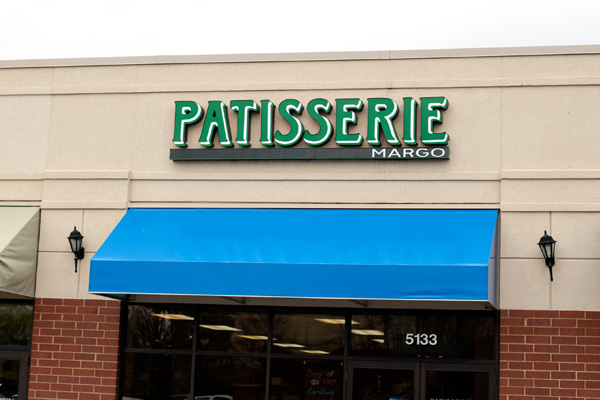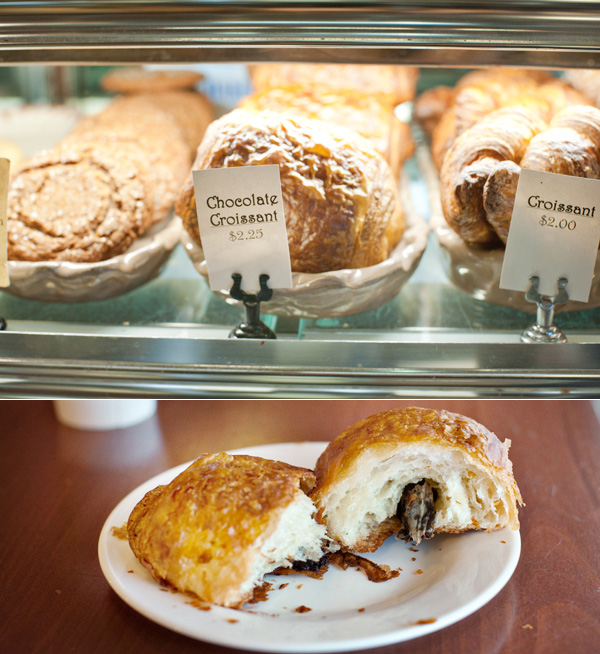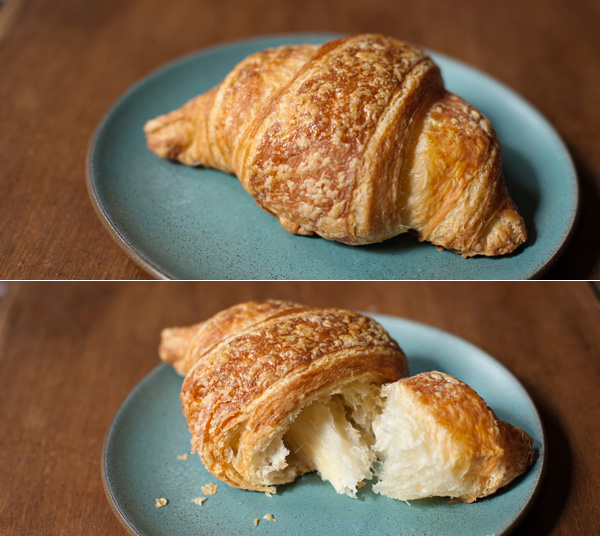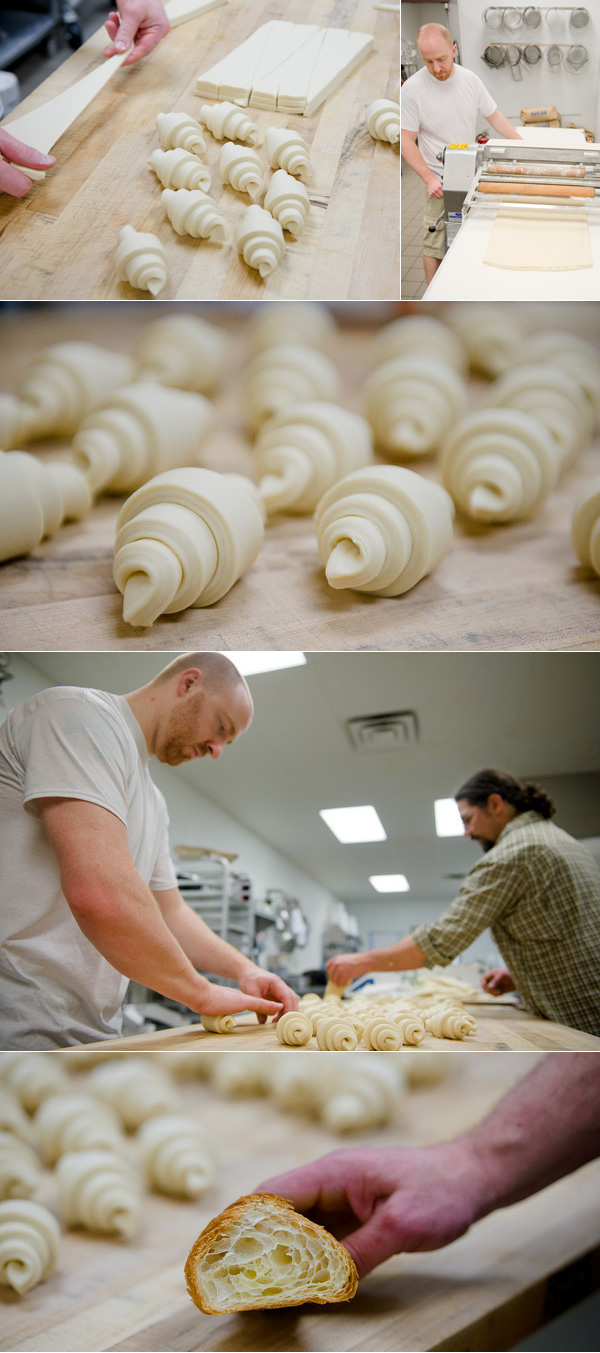
Step into any bakery of French or European influence, and the stimuli are plenty: colors of caramel, pistachio, apricot, and lemon; compositions of cream, curd, and crunch. Next to a sea of tantalizing contrast, the croissant recedes, destined to be perceived merely as ambiance. But at three Twin Cities bakeries, the croissant doesn’t need to vie for the customers’ attention. Chances are, it’s the reason they came.
Croissants are crafted by lamination, the technique of layering dough and butter. The process begins with a block of yeasted dough. A chilled sheet of butter is enveloped in the dough and rolled out. Next is the long and exacting dance of folding, rolling, and chilling. After the final rolling, triangles are cut and the croissants take their shape. They proof overnight, take an egg wash in the morning, and finally hit the ovens. That is, more or less, the sequence of events. If it seemed the least bit exhausting, steel yourself.

It’s Monday at Patisserie 46, and the front of the house is closed. In the kitchen, however, croissants are in production, and baker Andrew Mooney is making tracks. He grabs a book of dough from the cooler and walks briskly to the other end of the kitchen. While Mooney works, pastry chef and shop owner John Kraus explains that a dough block becomes a “book” once the butter is incorporated. Mooney runs the folded book through the sheeter, a mechanical rolling pin of sorts. Each time the dough is folded into thirds and passed through the sheeter, it’s considered one turn. Too many turns, Kraus warns, and you don’t get the distinguished layers of dough, butter, dough.
Even more critical to layer preservation is temperature. In textbook lamination, the dough and butter are the same temperature. The butter is pliable enough to stay flush with the dough as it’s rolled out, but chilled enough that it doesn’t get absorbed into the dough. Butter in such a textural state is said to be “plastic.”
Kraus grabs a day-old croissant off the rack, cuts it in half, and proudly displays the network of uniform air pockets contained within the crisp, dark crust. He knows he’s got a good thing going, but he’s hardly a croissant snob. “I never met one I didn’t like,” he admits.

Across city lines, Margo Bredeson takes a break from the helm of her namesake, Patisserie Margo. She talks about patience. “Croissants need to rise the right amount of time; you can’t hurry them.” She elaborates: Bake them too soon, and you’ve only allowed the outer layers to rise; the center is still dense. When the croissants enter the oven, the outside will rise quickly, leaving the inner layers behind. That’s when you get a croissant with a big gap in the middle. As Bredeson explains this, her gestures get bigger, her voice impassioned. She’s love struck, digressing into reverence for the layers and leavening properties of butter. She stops short, having rendered herself almost speechless. “It’s just… wonderfulness,” she concludes.

The last stop is Rustica, where head baker Tammy Hoyt introduces the pre-ferment. She’s the first to bring it up, and it’s evident why. Artisan bread is Rustica’s raison d’être, and pre-fermentation is essential in developing complex flavors. For the croissants, Hoyt uses a sponge pre-ferment. It’s a portion of the recipe’s flour, water, and yeast that’s mixed a day in advance, so the yeast can get a head start converting the carbohydrates into flavorful byproducts. According to Hoyt, the resulting croissant is more tangy and buttery, with a more pronounced wheat flavor.
She decides that she could tolerate a lower-quality butter, as long as the dough is pre-fermented. “I can always tell when it isn’t,” she says. “The taste falls a little flat.” (Note: Kraus also uses a pre-ferment; Bredeson does not, relying instead on a long, slow fermentation.)
These three bakers were consulted only after a single-judge vetting placed their croissants above all others. Any croissant from any one of these bakeries receives this writer’s stamp of approval. However, suggestions are in order:

The almond croissant at Patisserie 46
The first bite reveals a remarkable crunch. Crepe-paper-thin layers of crust are sealed tight, hardened like a cast. The crumb inside is moist and mingled with almond cream. The secret: It’s a day-old plain croissant, sliced and resurrected with orange blossom water. A thin layer of almond cream (browned almonds, powdered sugar, butter, and rum) goes in the middle, and a coating on top holds the slivered almonds secure as the pastry weathers the oven a second time. Out of the heat, it’s one light dusting of powdered sugar away from being the flashiest croissant in the building, and the best-selling.

The chocolate croissant at Rustica
Sometimes called pain au chocolat, this cuboidal pastry is made by cutting the laminated dough into a square and wrapping it around two batons of chocolate. At Rustica, the impossibly thin layers of the chocolate croissant curl under themselves like breaking waves. You could probably count more than 50 of them if you took the time. Inside you’ll find the evenly spaced batons (Hoyt uses Valrhona dark, 55% cocoa), still soft to the bite.
There’s one potential complaint here, and that is dryness. Rustica’s croissants spend a little extra time in the oven to help maintain a crisp exterior over time. Although this makes for notably dark (read: beautiful) croissants, a bit of moisture is bound to be sacrificed.

The plain croissant at Patisserie Margo
You’ll see them right away, in a basket on top of the bakery case. Handles turned in toward the bulbous middle, each croissant has a plump, contended look -– almost Buddha-like. Pick one up and it’s light as air, the fluffy white interior bound by a crust that crackles at slight pressure. Break off the crunchy handle and let it burst into shards between your teeth. Then draw out the butter-laced interior, the gossamer layers unfurling to the point of translucence. They’ll come in handy when it’s time to sweep the flakes that confetti your plate.
These croissants are the products of quality ingredients, refined technique, and the utmost respect of their bakers. That respect is difficult to muster until you’ve experienced firsthand what it’s like to be at the beck and call of a block of dough.
With that, it’s your turn – but not without a little advice.

Croissants at Home: Tips from the Pros
1. Bread flour or bust. You’ll find quite a few croissant recipes that call for all-purpose flour; some recommend a combination of all-purpose and cake flour.
The reasoning is that these flours have a lower protein content, which will turn out more tender croissants. It would follow, then, that high-protein bread flour produces tough croissants. But there’s a reason why Kraus (above, right, in green shirt), Bredeson, and Hoyt all use bread flour. Its ability to form strong gluten bonds facilitates a stronger rise; that’s how you get that flawless network of air pockets. Avoid a tough croissant by mixing a weaker dough (that is, under-mixing) at the start, because the dough gets tougher with every turn.
2. It can only be butter. A lot of cookbook writers describe a tradeoff in regard to using butter or margarine in your croissants: Butter gives you better flavor while margarine gives you better layers. Indeed, margarine’s waxy quality and comparatively high melting point ensures that it won’t ooze out during rolling. Some bakers encourage a compromise: half butter, half margarine, for the best of both worlds. Kraus’s thought on the matter: “We don’t talk about those people.” Choose butter with a high fat content (83% or higher) for greater malleability. Beyond that, work quickly and adhere most strictly to tip number three.
3. Chill. The intervals in the cooler are crucial. This is when the butter solidifies, fermentation slows, and the gluten strands relax, making the dough more extensible during the next turn. Step away from the fridge and let the dough work it out.
4. Disengage, but don’t check out. The proof is the final rise before baking. As Bredeson urged, you can’t rush this. Underproof your croissant and you’ll have a dense block. Overproof it, and the air pockets will expand too much; when they hit the heat of the oven, they’ll collapse. Master the final proof (and everything else) and you’ll be left with, well, wonderfulness.
Patisserie 46
John Kraus, owner / pastry chef
4552 Grand Ave S, Minneapolis
612.354.3257
Patisserie Margo
Margo Bredeson, co-owner / pastry chef
5133 Gus Young Ln, Edina
952.926.0548
Rustica Bakery
Tammy Hoyt, head baker
3220 W Lake St, Minneapolis
612.822.1119


The croissants at Trung Nam are probably better than all of these.
no Bread & Chocolate?
Is this Minneapolis-only? Trung Nam and Bars surely could compete with these, no?
Enjoyed this piece on TC croissants, but was dumfounded to reach the end and see no mention of Bread & Chocolate … I see that someone else had the same notion. They’re not the hot new kid on the block, but B&C has the croissants this croissant lover is willing to travel great distances for (well, from Southwest Minneapolis to St. Paul Crocus Hill). Craving Bread & Chocolate’s perfect almond croissant even as I write this …
I agree, there are a plethora of noteworthy croissants scattered across the Twin Cities metro. Likely too many to include in a single article. However, it appears that the writer chose to focus on French/European influenced establishments possibly to narrow it down a bit, no?
Same reaction — that other locations are overlooked, not necessarily because the actual product is less wonderful, but perhaps because the business is … less recent? less photogenic? less active at the PR mill?
MayDay Cafe makes my favorite croissant in the Twin Cities. I understand the “we had to narrow our focus” plaint, but am less sympathetic at the predictable results of such narrowing.
It would be great to see more coverage of places that are low-profile yet worthy discoveries (or re-discoveries), such as MayDay. Doing so would add more balance to the current phenomenon where the restaurant coverage overlaps so much that the media outlets seem to follow one another from one spnsored press event to the next.
Why, oh why didn’t the author visit EVERY place in the metro that makes croissants? I am outraged by this interesting and thoughtful article about croissants! I have no comment except to criticize!
Thank you, Neil! I appreciate an extremely well-written article simply reviewing a delicious pastry and a few different bakeries one can find said pastry.
Yum, these look delicious. My favorites are from A Baker’s Wife.
It would be nice to know, though, exactly which croissants the author tasted before deciding that these were the top 3…..
Wouldn’t it?
I guess it’s this line that leaves me curious which other bakeries were considered, and just how comprehensive the search was.
“These three bakers were consulted only after a single-judge vetting placed their croissants above all others.”
I would like to offer a clarification on a point in this article. In reference to me mentioning that I “tolerate a lower-quality butter, as long as the dough is pre-fermented”. After discussing with the author what I consider to be important factors in the flavor of all laminated doughs, we discussed butters and butter blends, preferment verses straight dough, various fermentation processes, etc. It is my opinion that for an croissant to have optimal flavor it should be complex: Butter, wheat, fermentation, caramelization. To achieve this I believe that a very good quality cultured butter should be used WITH a prefermented dough. When using the best butters ( the type that you would eat as is on a piece of bread, biscuit, etc.) a lot of the flavor of the butter is lost in the process of making a laminated dough. Our goal at Rustica is to use ingredients and optimize their flavors and characteristics. Not to use low quality products but the best product for any particular application.
Thank you for the mention in the post,
– Tammy Hoyt.
Head Baker @ Rustica Bakery
info@rusticabakery.com
I just thoroughly enjoyed reading this piece! It’s written so well! Then, I started reading comments, and am wondering what the issue is! Really? Are croissants so near and dear to reader’s hearts that they get all upset that their favorite bakeries weren’t showcased? You can still love your favorite places, your favorite croissants. You can mention your very favorites! But to be indignant that your choice was not covered? To be “unsympathetic” to the process the writer used to narrow the field? Really??? How can anyone take this writing and make it this controversial? This is how food reviews work! Don’t read them if you can’t simply enjoy them for what they are! And certainly don’t ruin it for the rest of us who appreciate someone’s work to share their discoveries!
I am very very sad you did not mention the May Day Cafe. All of these places listed above are quite excellent, but the May day Cafe has been hand making croissants longer than anyone else in town, all the way back to the first owner. Their croissants are outstanding and really are deserving of a mention, especially when they have also been open over 8+ years.
I kept thinking they would be mentioned. :(
For suburbanites who like easy parking as well as great food, try the croissants at
Patrick’s Bakery & Cafe, Southdale Square – 2928 W. 66th St, Richfield and
Pardon My French (2 locations – 1565 Cliff Road Eagan and new 2nd location North Garden Court at Mall of America, Bloomington)
Just test tasted May Day, Patisserie 46 and Rustica. Butter flavor stood out in May Day and could not be found in the others, of course the butter was there doing its job. Texture and lightness, holes and flakiness were present in all. My summary is that Minneapolis has some fantastic croissants available.
Stu, this is outrageous! What OTHER croissants did you try? WHAT ARE YOU TRYING TO HIDE???
I am angered with the whole premise of this article!!! Who cares about CROISSANTS. CINNAMON ROLLS!! CINNAMON ROLLS!! ANGER!! ANGER!!!!
OK, OK, so I admit I did buy one of the cinnamon rolls at May Day Cafe. It was really good too. One thing that I can’t hide is my expanding waistline. I was supposed to go the gym and work out. When I came home with three bags with bakery names on them my wife got suspicious. I had to admit that I skipped the gym today. Never mind that I went yesterday, but, at the door I met Jeff Victor, the musician keyboard player, and we visited for 90 minutes and then I just walked him to the parking lot got in my car and never entered the gym yesterday either. There is always tomorrow……….
I love the almond croissant! Why don’t they make Cheese croissants? Growing up in Nepal there was a German bakery in my hometown that made Cheese croissants and they were so delicious that I used to have one every single day. It wasn’t a lot of cheese but when you pulled the croissant in half then the thin layer of melted cheese could be pulled apart oh so good! I wish the bakeries out here would make cheese croissants. I really miss them here.
I was surprised to see no mention of Trung Nam either. Admittedly, I haven’t had croissants from the places you mentioned, but am SO looking forward to it. I would have liked to see honorable mentions too. OK, I know, it’s just croissant, but seriously, Trung Nam’s are amazing.